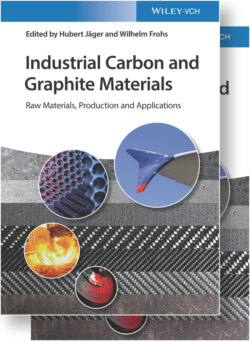Читать книгу Industrial Carbon and Graphite Materials - Группа авторов - Страница 12
1.1 Overview
ОглавлениеThis chapter provides information about the industrial importance of various carbon and graphite materials. Carbon and graphite materials are mostly unknown to the public. They are obvious in few consumer products only, such as lead pencils, or in sporting goods as carbon fibers, for example.
In contrast, the importance of carbon materials for the production of iron, steel, and aluminum is not common knowledge. The iron, steel, and aluminum industry created in 2011 a global market value of around 1100 billion €. This is equivalent to around 50% of the value of the global annual crude oil production. Although we will not consider metallurgical coke in this chapter, the market value should be mentioned; it is around 155 billion €. Also not considered here are carbon black (11 billion €) and activated carbon (1.8 billion €). The market value of carbon materials in total (without metallurgical coke) is at around 42 billion € (Figure 1.1). The biggest contributor with a market value of 18 billion € is carbon anodes for aluminum electrolysis. Within the group of polygranular carbon materials, the anodes are followed by graphite electrodes for the production of electric arc furnace (EAF) steel with a market value of six billion €. Smaller markets are cathodes for the production of aluminum (1.4 billion €), fine‐grained graphite for multifold applications (0.7 billion €), furnace linings for blast furnace steel production (0.3 billion €), and carbon electrodes for the production of silicon (0.2 billion €). Other carbon materials like natural graphite, carbon fibers, and graphite for Li‐ion batteries play a minor role versus the conventional carbon products yet. Changes may happen in the near future driven by the need for the efficient storage and use of energy. The market for conventional carbon materials will continue to grow driven by the demand coming from the BRIC countries (Brazil, Russia, India, and China).
New forms of carbon, the carbon nanomaterials, created huge expectations but are currently not produced in an industrial scale with the exception of multiwall carbon nanotubes (MWCNTs). With the recent demonstration of the potential of graphene, a single graphite layer, in microelectronic circuits, we might see the beginning of a new market for carbon materials.
Figure 1.1 Carbon materials and their market value.
